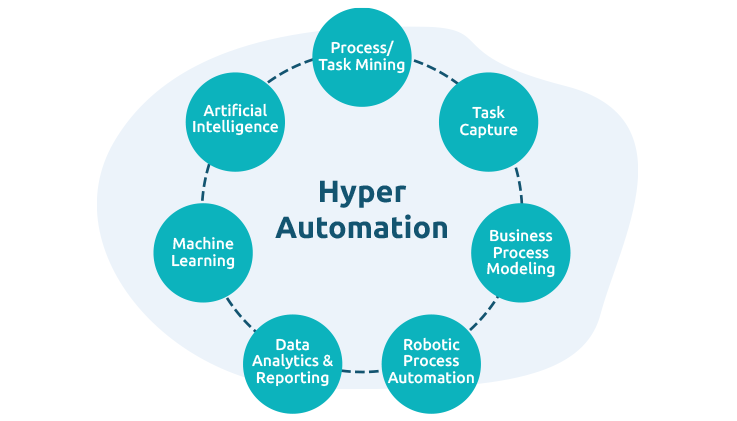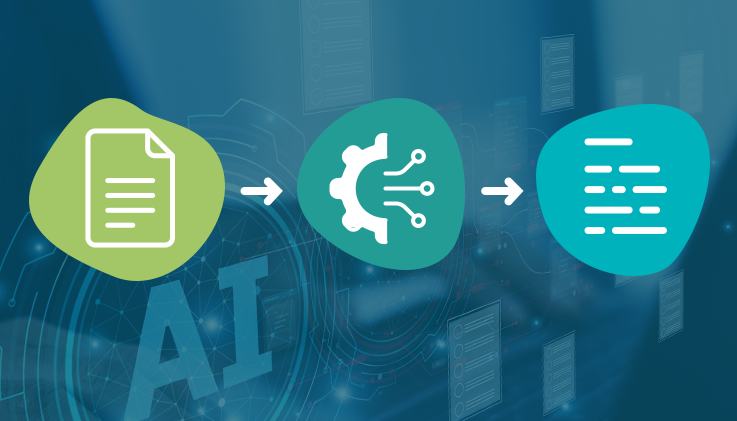Every organization — be it legacy business houses, modern enterprises, multinational corporations, local retailers, or small commerce within a neighborhood—dreams of becoming a customer success champion and providing value to clients. Ensuring value for consumers can be a lofty goal for enterprises, but with a little help from modern technology, the goal can be easily attained. Whether you are adding new services or adapting your business model to meet changing industry needs, hyper automation or intelligent automation helps your brand achieve optimum efficiency for your business's success.
Hyper automation eases the workload of live agents, streamlines workflows, enables seamless data sharing across the organization, and accelerates service delivery to clients. When automation is combined with AI, it becomes a true game changer–transforming how businesses operate and deliver value.
Why are businesses drawn toward hyper automation technologies?
Hyper automation brings transformative utility to customer support by automating complex, end-to-end processes that traditionally relied on human agents. By integrating technologies like artificial intelligence (AI), robotic process automation (RPA), and machine learning (ML), hyper automation allows support systems to handle repetitive tasks such as ticket routing, data entry, and initial customer triage with high accuracy and speed. This frees up human agents to focus on more nuanced or emotionally complex interactions.
Furthermore, hyper automation enhances customer experience through intelligent virtual assistants and chatbots that can understand and respond to queries in natural language. These systems learn from interactions over time, continuously improving their ability to resolve issues independently. When combined with predictive analytics, hyper automation can anticipate customer needs or problems before they arise, enabling proactive support interventions that foster customer loyalty and satisfaction.
On the backend, hyper automation provides valuable analytics and process insights by tracking workflows and identifying inefficiencies or bottlenecks. Support managers can use this data to refine operations, allocate resources better, and even redesign support structures to be more agile. Overall, hyper automation creates a more responsive and scalable support ecosystem.
Also read: Role of Data and Analytics in Improving Customer Engagement
Intelligent automation helps attain customer experience goals
Integrating intelligent automation and AI set the stage for uncovering customers’ expectations. AI helped businesses get a closer look at their customers’ personas, what customers needed, and what they wanted. As businesses saw their customers in a new light, they understood the true magnitude of customer expectations. With the passage of time, businesses were able to deliver the results that customers expected.
Companies, big and small, were quick to visualize the revolutionary outcome of implementing automation and AI in their day-to-day business functions. The response from customers and support teams was very encouraging. Customers loved the integration of automation and the shorter turnaround times, besides appreciating inputs given by the AI. Agents were relieved at being able to easily find accurate answers to customer queries and praised the quality of solutions suggested by the helpdesk AI.
In some cases, delivering solutions and experiences that were beyond customers’ expectations had a positive effect on businesses. Customers felt satisfied and happy. By exceeding consumer expectations, many enterprises saw their customers turn into fierce brand loyalists.
Let us look at these scenarios where we can see hyper automation making the lives of customers and support agents better.
Scenario 1: Intelligent automation prevents cart abandonment and guarantees sales
Casper is all excited about his 30th birthday. He wants to invite his friends from college and have a grand reunion. However, in his excitement, he forgets another important day—his wedding anniversary, which comes a day before his birthday.
By the time he realizes his mistake, it is already evening, and his wife will be home from work. Casper wanted to surprise her. So he thought, and he thought fast. He opened his mobile phone and scanned a food delivery app that had a gourmet dessert store listed on it.
A few clicks and an order for a blueberry cake was placed. Casper sighed with relief. Everything was perfect until Casper received a message from the dessert store saying, "Sorry, but his order would not be delivered." The store had run out of all cakes requiring fruit, and they would be able to deliver the next blueberry cake only after 12 hours.
Upon learning of his order cancellation, Casper becomes glum. He tries to place another order but abandons the cart. This was when the food delivery company’s AI-powered hyper automation embedded in their helpdesk sprang to action.
The first thing the automated conversation bot did was apologize for the order cancellation and reinstate the amount back to his bank account. Further, sensing that he was still looking for cake, the app offered him a selection of chocolate cakes different from the ones he had checked earlier. It did not take long for Casper to select another cake—and his order was placed without any extra hassle. Casper was able to surprise his wife. The best part? All of this was done without raising any complaint.
The alert and efficient AI identified a frequent customer abandoning the cart and immediately started to analyze all previous transactions to identify the reason for the sudden friction in the customer’s journey. To ensure sales and customer retention, measures were in place to ensure the business continued, irrespective of any situation.
Hyper automation can provide better productivity and reduce expenses, thus increasing sustainability and improving team efficiency to provide better results and more return on investment.
Besides, hyper automation also does a very good job of meaningfully contributing to the efforts of customer service agents and helping companies unlock new possibilities to improve the customer service experience.
Enterprises that have implemented intelligent automation in their regular functioning enjoy these benefits:
- Increased efficiency
- Enhanced productivity
- Cost savings
- Improved accuracy
- Enriched customer experience
Here is another scenario to explain how hyper automation can remove barriers to communication.
Scenario 2: Collect precious customer data and provide contextual information to clients with hyper automation
Jasper is visiting his family over the holidays. He plans to take his mother’s car up for a hike in the nearby mountains. The engine is fine, but it is the tires that need a second look. He searches for the service history of the car but cannot find it. He takes the car instead to the service center.
Sure enough, a quick search with the license plate number pulled up all the details, including the calls to his mother’s number informing her about her missed appointments at the service center. Jasper gets the necessary servicing done for his car and signs in to receive timely updates about the car on his social media account.
This way, Jasper has a backup should communication with his old parents falter somewhere. The layer of redundancy Jasper has created to ensure the smooth running of his mother’s automobile is reinforced with appropriate usage of customer data and a few workflows incorporating hyper automation.
What is the difference between automation and hyper automation?
While automation is limited in the sense of automating preconceived and repetitive tasks, hyper automation, on the other hand, improves the whole situation drastically by promoting smart and accommodative tactics that offer guidance on the subsequent course of action rather than performing the same activities on a loop.
Let us go through the various steps necessary to include hyper automation in any business process.
- Process discovery: The first step towards automating any activity would be looking at the process in its entirety. Using task mining tools and analytics to find out how systems and users perform.
- Analyze how your process functions: Look at your workflows minutely and find out the causes of any roadblocks or bottlenecks that hamper your efficiency.
- Streamline your process design: Leverage low-code or no-code technology to create and change workflows, implement digitalization, and focus on personalization. Identify and implement intelligent automation in your process to boost efficiency.
- Use data and analytics: Measure all aspects of your business and obtain valuable insights into areas like customer engagement, product development, marketing, etc. Utilize analytics to stay updated about your business functions.
Hyper automation complements business processes
Can you club hyper automation to technologies and workflows within an organization without disrupting other processes? Yes. Hyper automation utilizes AI-based automation processes and can be created in setups consisting of multiple technologies, systems, and platforms together.
Here is a list of a few business activities that have their roots in automation.
- Robotic Process Automation (RPA): RPA is not a new feature in customer service. In fact, it is one of the oldest and most widely used business process automation features. Successfully integrated RPAs within workflows can help complete repetitive business tasks without the need for human supervision. Truth be told, any type of activity/business process that requires a clear sequence of actions repeating itself to be completed successfully can be done through RPA.
- Business Process Management (BPM): Intelligent business process management is the discipline in which people use various methods to discover, model, analyze, measure, improve, optimize, and automate business processes. In fact, any combination of methods used to manage a company's business processes is BPM.
- Artificial intelligence (AI) and machine learning (ML): Low-code systems and business processes utilizing AI and ML. AI and ML are a perfect fit for process automation and decision management. Today, an AI-enabled process change means an improvement in existing processes, and the benefits of such an activity resonate throughout the organization. Look closely, and it becomes clear that modifying preset functioning styles with AI is akin to modifying the structural design of an organization.
- Data and analytics: Data from analytics and reports helps in learning, observing, and evaluating outcomes. The details of how a process functions (under various preset conditions) and the results obtained are valuable resources. The data comprises all minute details and is analyzed by companies to identify anomalies like fraud, for example.
Besides casting light on consumer necessities/preferences, data from various analytics gives a clear picture of what consumers want, as well as provides a quantifiable measure of how much is acceptable to the public.

The future of customer service looks promising with hyper automation
Today, the modern customer demands premium quality of service and attention from every brand they encounter. Customers expect prompt answers and lasting resolutions to all their problems—without wasting a single moment waiting for answers or help.
Rapid digitalization has shown that technology is capable of bridging gaps between people and transforming dreams into reality. Most consumers today believe that clients going behind companies is a thing of the past. Instead, they want brands to make use of digitalization and technological advancements to stay focused on consumers and come to them instead.
Hyper automation can fulfill consumer demands at super-fast speeds
Consider this statistic from HubSpot research: ‘90 percent of customers rate an immediate response as essential or very important when they have a customer service question. 60 percent of customers define 'immediate' as 10 minutes or less. Patrons are more likely to switch to competitors if they experience delayed response and disjointed service delivery.
Even as businesses reel under pressure to serve all customers in a timely and efficient manner, hyper automation, with its potential to improve business productivity and service quality, emerges like a boon from God to save businesses and help customers.
Gartner predicts that the global market for tools and technology related to hyper automation is expected to increase 12 percent to US $596 billion in 2023. The benefits provided by hyper automation to businesses and its contribution to customer service are appreciated globally.
Hyper automation can improve productivity and reduce expenses, thus increasing sustainability and improving team efficiency, resulting in better results and more return on investment. Hyper automation also does a very good job of meaningfully contributing to the efforts of customer service agents and helping companies unlock new possibilities to improve the customer service experience.
Also read: Why Businesses Prefer Cloud-Based Helpdesk Software for Customer Service
Hyper automation is the mainstay of most industries
A wonderful characteristic of automation technology is its wide reach among users and seemingly endless opportunities where it can be used. In the last decade, automation (in its various forms) proliferated countless industries and revolutionized how work is done. There is no limit to how much work can be automated. Rather, the final objective is to ensure that customers benefit from innovation and technology. Figuratively speaking, for most industries, the sky is the limit to what can be achieved with automation.
The invention of new systems and the innovation of existing ones have ushered in a period that can be appropriately termed the ‘democratization of technology’—where there are abundant technology resources for those seeking. Intelligent automation technology that was earlier considered a “good to have” feature has now become a “must have” functionality.
Across industries, we can see that more and more responsibilities (including tasks that are critical, repetitive, or both) are being delegated to machines and automation systems. Machines are able to successfully accomplish work objectives without the need for any human supervision. Service agents are able to invoke an additional layer of automation support to help them in customer service activities.
This has not only improved the quality of overall CX but has also made business processes and workflows more systemic and efficient. Here is a list of a few industries that are making the most of the situation and benefiting immensely by incorporating automation in their functioning.
- Banking and finance
- Insurance (general and health)
- Manufacturing
- Construction
- Health care
- Retail
- Human resources management (recruitment, payroll processing)
- Customer service
Hyper automation can provide better productivity and reduce expenses, thus increasing sustainability and improving team efficiency to provide better results and more return on investment. Besides, intelligent automation also does a very good job of streamlining workflows, meaningfully contributing to the efforts of customer service agents and helping companies unlock new possibilities to improve the customer service experience. Explore solutions by ThinkOwl, and book a free demo.













